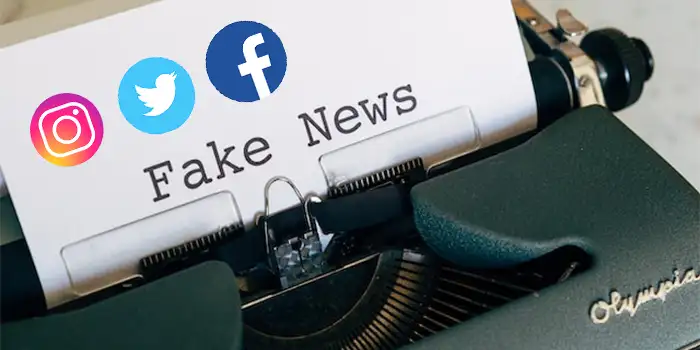I’ve already witnessed a lot of fake news on social media and the impact that it brings creates chaos in the society. The common fake news that I saw is more on political scandals and health crises. That’s why I always check the credibility of the post and the page to avoid misinformation.
The rise of social media has been identified as a major contributor to the rise of fake news, as it provides a platform for false information to spread quickly and easily to a wide audience. The ease of sharing content makes it easy for fake news to gain traction and spread rapidly.
In this article, you’ll learn:
How does Social Media Contribute to the Spread of Fake News
You’re mistaken if you believe that users are the only ones accountable for propagating false information. I’m going to list the several ways that social media contributes to the spread of fake news.
1. This is the Viral Nature of Social Media
There is a famous game called “telephone”. The game is played by whispering the message to one person, who then passes it on to the next person until the message reaches the last person.
The last person will suddenly say it out loud. The message that the last individual receives almost always differs from the original message that was sent.
Well, I can compare social media to the game called telephone. When someone will post something on social media, it can easily be shared and reshared by a lot of other users.
But, sometimes, it has changes or additions already. The content that was posted and shared can move so quickly that’s why it can be hard to fact-check every piece of information that you see.
That’s the viral nature of social media, it can make fake news spread like wildfire. A single post can be suddenly seen by hundreds, even thousands of people. Then it will be shared with their followers.
2. Confirmation Bias of Algorithms
Have you noticed that social media platforms seem to know what you like? They show you ads or content that are similar to what you liked before.
Well, it’s all because of social media algorithms. It is designed to show you some content that they’ll think you’ll be interested in. At the same time, algorithms also analyze your behavior on the platform.
The downside of this personalized content that’s provided by the algorithm is that it can create confirmation bias.
It means that users are more likely to believe information that confirms their existing beliefs. Then they will ignore the information that will challenge their beliefs.
A lot of users today are very one-sided because they are only presented only one point of view on their feed. They don’t even question the information or fact-check it. They directly assume that it is true.
The sad thing about this is if they suddenly realize the information was false then it was already too late. They have already shared that kind of content and a lot of their followers believe in it.
3. Ease of Sharing
I’ve seen a lot of users on social media that shared a post without actually reading it first. That’s why I’m not shocked why most users don’t also fact-check what content they share.
Social networking sites today are very easy to use because, with just one click of the share button, you can pass along information.
Fake news spread like wildfire because of the ease of sharing. Once a user saw a headline that sounds interesting, they will hit the share button without actually checking or verifying the information.
This kind of behavior is not new and social media platforms always educate their users to be responsible for what content they share.
We must keep in mind that not everything of what we read or see on social media is real. Because spreading false information can have an adverse effect on others, users must always exercise caution.
We must actively participate in fact-checking rather than relying on social media networks to do it for us.
4. Bot Networks
Maybe you’re not familiar with bot networks but these are the computer programs responsible for doing certain tasks automatically like posting or sharing of content.
The sad thing is, some individuals are using bot networks to spread fake news on social media platforms.
I’ve seen a lot of posts on social media that I thought it was coming from a news organization when I looked into it more deeper, I realized it was created by a bot network.
The post was really designed like legitimate news but the information was completely false.
It’s very hard to identify posts that were created by a bot network that’s why lots of users can be tricked by it. It’s important to be aware of bot networks and we must do our research to verify the information that we see on social media.
5. Lack of Fact-Checking
But wait, the lack of fact-checking is more of the user’s fault right?
Well, individual users are indeed the ones responsible for fact-checking the information but I believe that social media platforms can do more to help combat this issue.
For how many years, social media platforms are doing their best to combat this issue but they are failing to implement fact-checking mechanisms.
They are not doing enough to promote media literacy and critical thinking among their users.
Many people have criticized social media sites like Facebook and Twitter for how they handle fake news. The 2016 US presidential election was one of the most significant occurrences I could still recall.
The efforts that social media platforms are doing were met with a lot of mixed success and until now it is difficult for them to effectively combat fake news.
How Users Spread Fake News on Social Media
Fake news spread rapidly on social media platforms and we all agree that at some point, users are the ones to blame. Here are some ways that I believe users contribute to the spread of fake news.
Social Sharing
People propagate bogus news mostly through social sharing because people just want to share what they want to share. They are unconcerned about the credibility of the material.
As you can see, members of social media platforms like Facebook and Twitter may now easily share content. The simplicity of sharing is what encourages people to disseminate falsehoods.
Lack of Fact Checking
Lack of fact-checking is another way that people help fake news circulate on social media.
Some users just love to read an article but they don’t to confirm if it’s credible or not. In addition, I’ve seen a lot of users trust information that comes from sources that they think are credible even though it’s not.
Malicious Intent
Last but not least, there are individuals on social media sites who purposefully aim to distribute false information. They seek to polarize or confuse the people by doing this.
Every time there is an election, I witness a lot of bogus news that is produced with ulterior motives. They carry out this action in order to further a political objective. Because malicious users create fake accounts to influence the public, this is extremely concerning.
How to Identify Fake News on Social Media
I want to remind you if you often use various social media platforms that false news is on the rise and can occasionally be hard to spot. Here are some methods for spotting false information on social media:
- Check the Source: Checking the credibility of the source of the news article or post is very important. Try to look for trusted sources. For example, if that news page has a television channel, it surely means that page is credible. Users must always be cautious of the sources they haven’t heard of because oftentimes they are credible.
- Look for Supporting Sources: Verify whether the same story is being covered by other reliable news sources. It may be false news if there is only one source reporting a spectacular story.
- Examine the Content: Read the full post or article and seek any indications that it could be a scam. Does it have grammatical or spelling mistakes? Is the tone too dramatic or prejudicial? Are the references cited in the story reliable?
- Check the Date: Verify the post or article’s date. It’s possible for old fake news articles to be recycled or disseminated again, which might be deceiving.
- Verify Images and Videos: Videos and images can be edited to propagate false information. Verify the validity of photos using reverse image search engines, and search for indications that movies may have been manipulated.
- Check the Author or Page: Verify the post’s or article’s, author. Is the author trustworthy? Do they have a track record of fabricating news? Check also the history of the page if they are legitimate sources of news.
- Use Fact-Checking Tools: You may examine the veracity of news items and sources online using a range of fact-checking tools.
So, identifying fake news is not that really hard. Sometimes, you just need critical thinking and skepticism so that the content that you consume is not false news. You can help stop the spread of fake news if you will apply the tips that I’ve provided.
How to Prevent Fake News on Social Media
Preventing false news on social media is a difficult subject that necessitates a variety of techniques.
But there are many ways how we can prevent this problem and the preventive measures that I will provide are the ones that I’ve been doing for how many years to combat fake news.
Educate Yourself
I think that educating ourselves is one of the most effective methods to stop fake news. We must become critical consumers of the content that we see on social media. You must know how to compare credible and false information.
The way to start educating ourselves is to start by learning about credible sources. Real and false news will be tough for you to distinguish if you don’t understand what a reliable source is.
Verify Sources
Check the source of a news article before you trust it or spread it. Is it a dependable news source or a chance blog? Usually, the URL of the website or a fast Google search will provide this information.
Verifying the sources is critical since it allows us to confirm that the information we get is correct. When we verify the sources, we can avoid the spread of misinformation which can be harmful to others.
Avoid Sensational Headlines
Have you seen a headline on social media that was so shocking? Headlines like, “Covid-19 Vaccine Can Turn Us Into Zombies!”
Well, these sensational headlines are so annoying for me and I’m pretty sure these are fake news. They want to exaggerate their headlines so that people will click.
Take a moment to relax and consider your next move before clicking the share button if you read a stunning headline. Consider whether the narrative appears too fantastic or ludicrous to be genuine. Maybe they just want to grab people’s attention.
Report Fake News
By taking action to maintain our social media feed free from false information, reporting fake news is a crucial step in the prevention of fake news. We are also helping to protect other users from consuming those kinds of content.
If we can identify fake news and report it, it can alert social media platforms to take action. The platform’s moderator and algorithm will then review it and remove it if it is proven to be not credible.
Use Fact-checking Tools
Fact-checking tools are also essential in preventing fake news because these tools will verify the accuracy of the information.
There are a lot of popular fact-checking tools such as Snopes and FactCheck.org. There are also browser extensions that can be less hassle like NewsGuard.
When using a fact-checking tool, you copy and paste the link to the article or blog post you want to examine. If the content is false, the tool may provide alternative information that is more reliable.
Encourage Critical Thinking
I encourage you to use your critical thinking in preventing fake news on social media because this is an excellent way to evaluate information to determine its accuracy.
You must evaluate the tone of the posts if it is overly emotional or inflammatory in language.
Using critical thinking means using your brain and questioning your own biases. Users must be aware of their own biases because they can affect how they interpret the information.
To analyze the material objectively and without bias, we must approach it with an open mind. preconceived ideas.
Final Thoughts
There you have it! You have learned that social media is really a powerful tool, but it’s not without its challenges.
We always need to check the sources of information and share responsibly. By doing so, By doing so, we can make social media a place where truth prevails and misinformation is kept at bay.
It’s a collective effort, and together, we can ensure that social media remains a force for good in our world.










